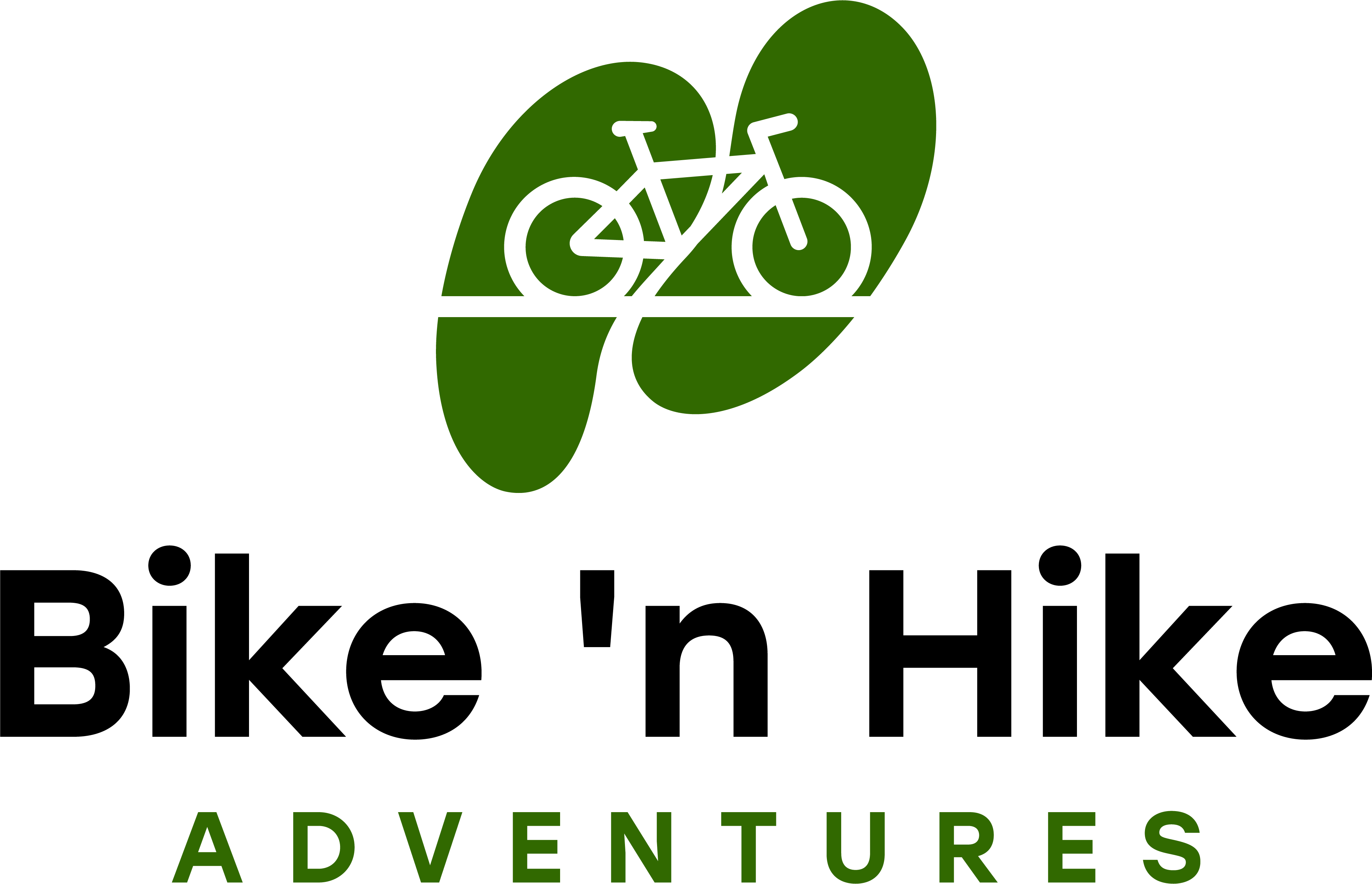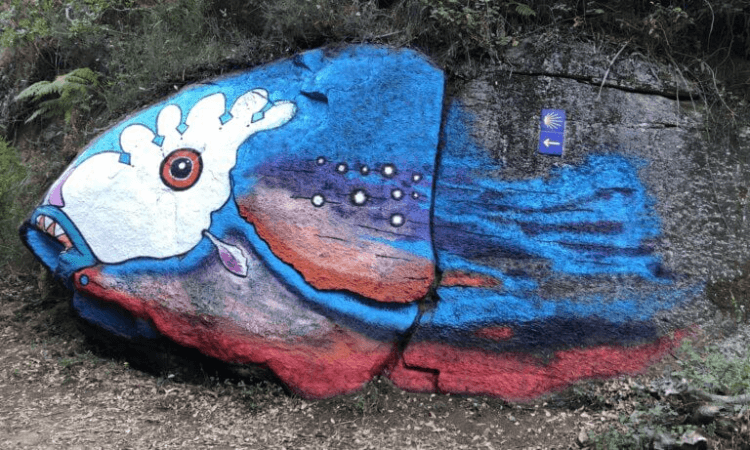
Camino Cycle
I was out cycling on the Camino Trail in 2019, which was my last major trip before Covid shut down the world. I had several planned for the following year – some still to be done.
I am not sure what led me to consider the Camino as a cycling route. I am so glad I did – it was an incredible experience, shared with an incredible group.
WHAT IS A CAMINO WAY CYCLE TOUR?
I knew some people who had hiked this pilgrimage journey to the Cathedral of Santiago de Compostela in Spain. However, hiking so far each day (~30K or 19M) for so many days in a row (e.g. 4-6 weeks for the classic Camino Francés route which is 680KM or 422M) did not really appeal to me. I likely went to a Camino site and read about cycling options. I learned that approximately 15% of pilgrims follow the route by bike, and that cyclists on the Camino are known as ‘bici-grinos’ (bike-pilgrims).
For those of you not familiar with the Camino, here is some background from https://caminoways.com/
The Camino de Santiago, also known as the Way of St. James, is a renowned pilgrimage of medieval origin that sees pilgrims journey to the Cathedral of Santiago de Compostela in Galicia in the northwest of Spain.
Legend has it that the remains of the Apostle St. James the Great were buried in the Cathedral and discovered by a shepherd in the 9th century. The city of Santiago is named after St. James: Santiago de Compostela means St. James of the Field of Stars.
Due to the enduring popularity of the Camino de Santiago and the many Camino routes, they have been listed as a UNESCO World Heritage Site since 1993. The Camino’s essential role has encouraged cultural exchanges between people from all over Europe and the world for many centuries.
The Camino de Santiago has been internationally recognised as one of the historic symbols of European unity. The pilgrim route was chosen as the first European Cultural Route by the Council of Europe in 1987. The Camino and the architecture along its routes are also listed as UNESCO World Heritage Sites.
The Camino pilgrimage has been around for over 1,000 years, dating back to the 9th century when the remains of Saint James were found in northern Spain. There are many routes to choose from, as traditionally the pilgrimage is supposed to start from your home.
After a lot of research, I decided to do the Portuguese Coastal route. The route was flatter than the mountainous route along the north of Spain, and at 252KM (157M) was comfortable over 6 days of cycling. And, I had never been to Portugal.
THE PORTUGUESE WAY
I was able to find a group of people willing to accompany me on this journey.
We had some drama on our first cycle morning as our tour provider had arranged for a bus to take us to the start. What we really needed was a smaller bus for 18 people and a cart for the bikes. What was there was a tour bus for 50 people. After a lot of discussion between our Portuguese speaking guide and driver, the decision was to put as many bikes as possible in the luggage compartment, and bring the rest inside the bus to sit in the aisle.
Not perfect, but it worked. Members of the group helped to store the bikes, we got to the destination, and the driver got a really good tip! Travelling sometimes involves unexpected things! My key lesson – always have a guide that speaks the local language! As we started cycling, I found out what “diverse terrain” meant. On Day 1 we had pavement, wooden paths, sand, rocks, construction, roots, hard packed earth. At one point we had to carry our bikes because the path was through a woodland area with dense trees. However, the good humour of the group prevailed and we successfully made our way into Esposende, a seaside city in northern Portugal.
Day 2 had a different challenge, called “hills”. Those who opted for an e-bike sailed up without effort. I had to walk the bike at times. Our strongest rider was 82 years old and conquered all the hills on the regular bike. You never know what skills and abilities group members have until you journey together.
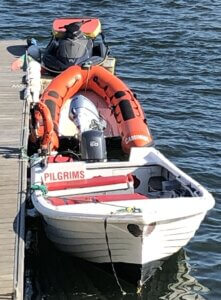
Boat taxi for people and bikes
Wayfinding was quite easy along the route, the seashells kept you on track. It is said that the this symbol is a metaphor, with all the lines representing the routes travelled by pilgrams all leading to one point, the tomb of Saint James in Santiago de Compostela.
Examples of markers along the route to keep you on the right path to Santiago:



A collection of Camino shells, all pointing the way to Santiago de Compostela


ARRIVING IN SANTIAGO DE COMPOSTELA
On the last day we cycled into Santiago de Compostela. What an achievement – for us – and for everyone else arriving on the same day, by bike or by foot. That complete sense of accomplishment was felt by everyone, no matter where they started from, or when. We waited to receive our certificate and spoke to others and heard their stories. One person had started his walking pilgrimage in the UK. Some had done the full Camino. Each story, unique. These days, many do the Camino as a physical and mental challenge, or in honour of a special person. You see others on the route for whom the walk is a religious pilgrimage. The diversity along the route impressive and no matter how you do this trek you feel part of a global community.
Of course, we headed to the cathedral, an important stop for all pilgrims. At the time, it was undergoing extensive renovations. Notwithstanding all the scaffolding and cover-ups, you could see what a magnificent building it was. We also visited the town – Santiago de Compostela “old town” is a UNESCO-listed heritage site since 1985, with its university dating to 1495. So many people on the streets and in the cafes. There was a vibrancy I don’t think I had experienced before. We were staying a night in Santiago, and our accommodation was an old Monastery – such an appropriate place to stay for such a journey.
Our cycling journey had ended and we bid adios (Spanish) and adeus (Portuguese) to our fabulous guide. What a great week we had all had cycling together. From the early frustrations at the beginning of the week, to the exhilaration of completing more than 200 KMs of cycling several days later, we had shared so much. Now, we all had a whole new group of travel companions.
Where else can I ride my bike?
Where would you like to go?
Maybe we could go together?
3 highlights:
- Our amazing trilingual guide (English, Portuguese, Spanish) who made sure we all arrived at the daily destination safely and together
- The stories from fellow pilgrims, each unique
- The feeling of being awestruck as you contemplate the number of people who have done this pilgrimage over the centuries, and thinking about what they might have endured along the way
3 things for the next time:
- Visit the amazing Cathedral of Santiago de Compostela when the restorations are complete
- Choose a different route to cycle the Camino – there are so many! Maybe the traditional French Way? Or, the Camino del Norte which follows the coast of Northern Spain?
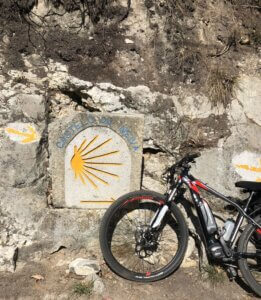
I was out cycling on the Camino Trail in 2019, which was my last major trip before Covid shut down the world. I had several planned for the following year – some still to be done.
I am not sure what led me to consider the Camino as a cycling route. I am so glad I did – it was an incredible experience, shared with an incredible group.
WHAT IS A CAMINO WAY CYCLE TOUR?
I knew some people who had hiked this pilgrimage journey to the Cathedral of Santiago de Compostela in Spain. However, hiking so far each day (~30K or 19M) for so many days in a row (e.g. 4-6 weeks for the classic Camino Francés route which is 680KM or 422M) did not really appeal to me. I likely went to a Camino site and read about cycling options. I learned that approximately 15% of pilgrims follow the route by bike, and that cyclists on the Camino are known as ‘bici-grinos’ (bike-pilgrims).
For those of you not familiar with the Camino, here is some background from https://caminoways.com/
The Camino de Santiago, also known as the Way of St. James, is a renowned pilgrimage of medieval origin that sees pilgrims journey to the Cathedral of Santiago de Compostela in Galicia in the northwest of Spain.
Legend has it that the remains of the Apostle St. James the Great were buried in the Cathedral and discovered by a shepherd in the 9th century. The city of Santiago is named after St. James: Santiago de Compostela means St. James of the Field of Stars.
Due to the enduring popularity of the Camino de Santiago and the many Camino routes, they have been listed as a UNESCO World Heritage Site since 1993. The Camino’s essential role has encouraged cultural exchanges between people from all over Europe and the world for many centuries.
The Camino de Santiago has been internationally recognised as one of the historic symbols of European unity. The pilgrim route was chosen as the first European Cultural Route by the Council of Europe in 1987. The Camino and the architecture along its routes are also listed as UNESCO World Heritage Sites.
The Camino pilgrimage has been around for over 1,000 years, dating back to the 9th century when the remains of Saint James were found in northern Spain. There are many routes to choose from, as traditionally the pilgrimage is supposed to start from your home.
After a lot of research, I decided to do the Portuguese Coastal route. The route was flatter than the mountainous route along the north of Spain, and at 252KM (157M) was comfortable over 6 days of cycling. And, I had never been to Portugal.
THE PORTUGUESE WAY
I was able to find a group of people willing to accompany me on this journey.
We had some drama on our first cycle morning as our tour provider had arranged for a bus to take us to the start. What we really needed was a smaller bus for 18 people and a cart for the bikes. What was there was a tour bus for 50 people. After a lot of discussion between our Portuguese speaking guide and driver, the decision was to put as many bikes as possible in the luggage compartment, and bring the rest inside the bus to sit in the aisle.
Not perfect, but it worked. Members of the group helped to store the bikes, we got to the destination, and the driver got a really good tip! Travelling sometimes involves unexpected things! My key lesson – always have a guide that speaks the local language! As we started cycling, I found out what “diverse terrain” meant. On Day 1 we had pavement, wooden paths, sand, rocks, construction, roots, hard packed earth. At one point we had to carry our bikes because the path was through a woodland area with dense trees. However, the good humour of the group prevailed and we successfully made our way into Esposende, a seaside city in northern Portugal.
Day 2 had a different challenge, called “hills”. Those who opted for an e-bike sailed up without effort. I had to walk the bike at times. Our strongest rider was 82 years old and conquered all the hills on the regular bike. You never know what skills and abilities group members have until you journey together.
Boat taxi for people and bikes
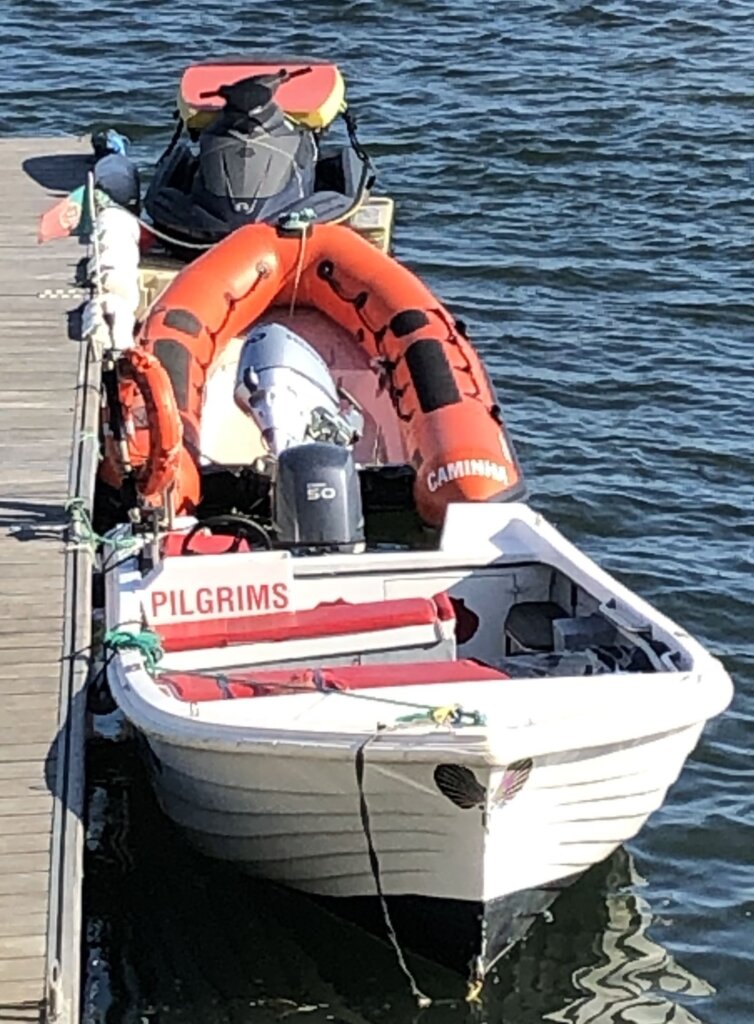
The next three days were wonderful and drama free. We cycled up the coast, often with the water by our side. We saw delightful towns such as Vigo, Pontevedra and Padron, each with its own character and unique features that made for special Instagram moments for everyone. So many charming statues, fountains, and churches. Taking the boat taxi from Portugal to Spain (one more time hauling bikes!) was really fun.
Wayfinding was quite easy along the route, the seashells kept you on track. It is said that the this symbol is a metaphor, with all the lines representing the routes travelled by pilgrams all leading to one point, the tomb of Saint James in Santiago de Compostela.
Examples of markers along the route to keep you on the right path to Santiago:
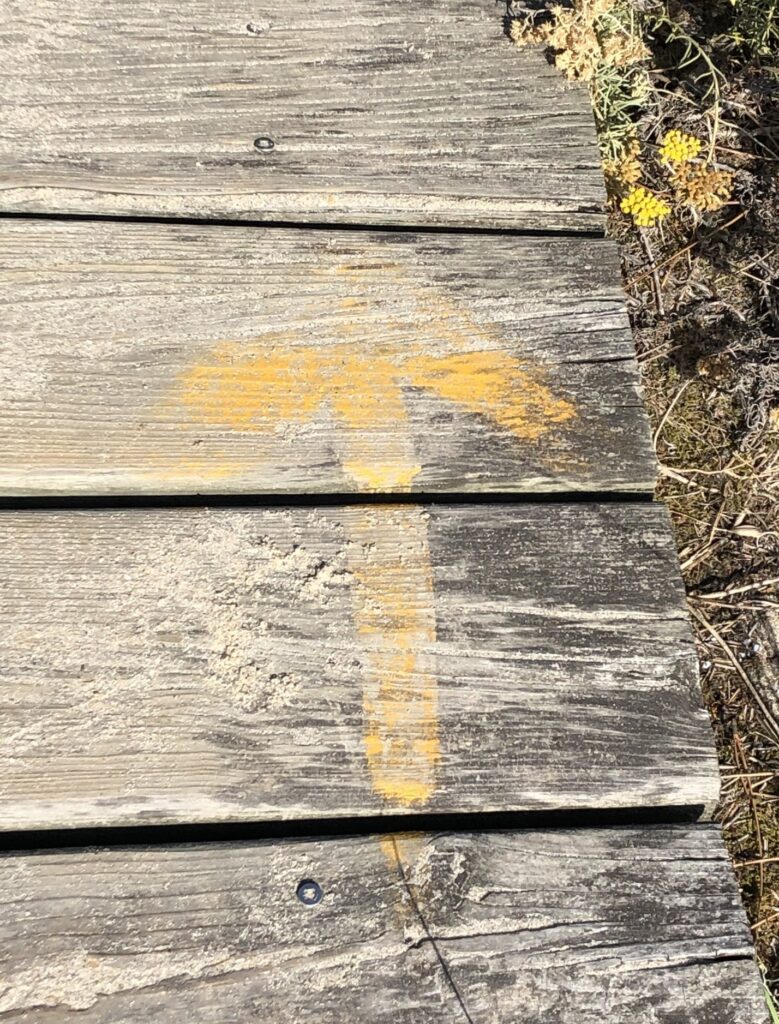
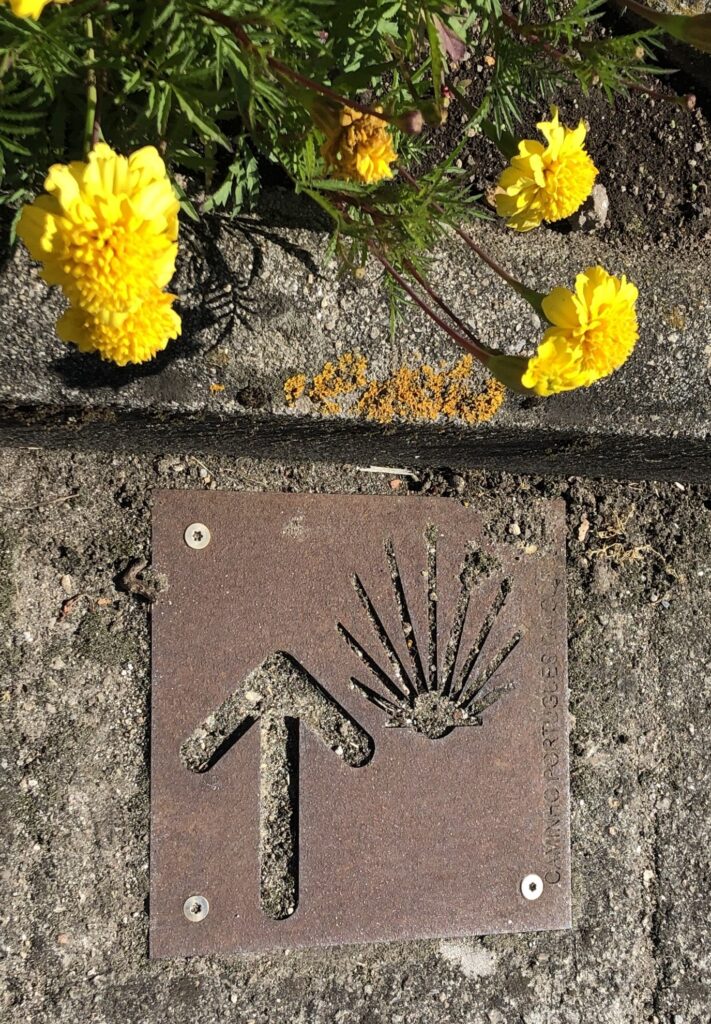
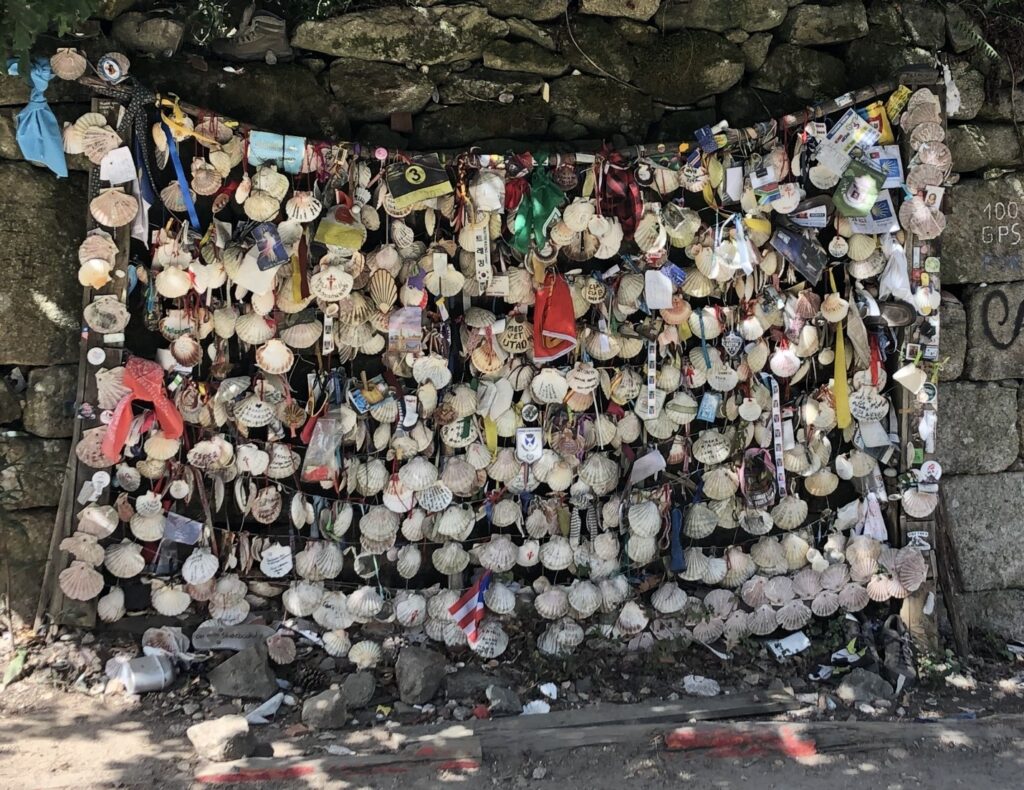
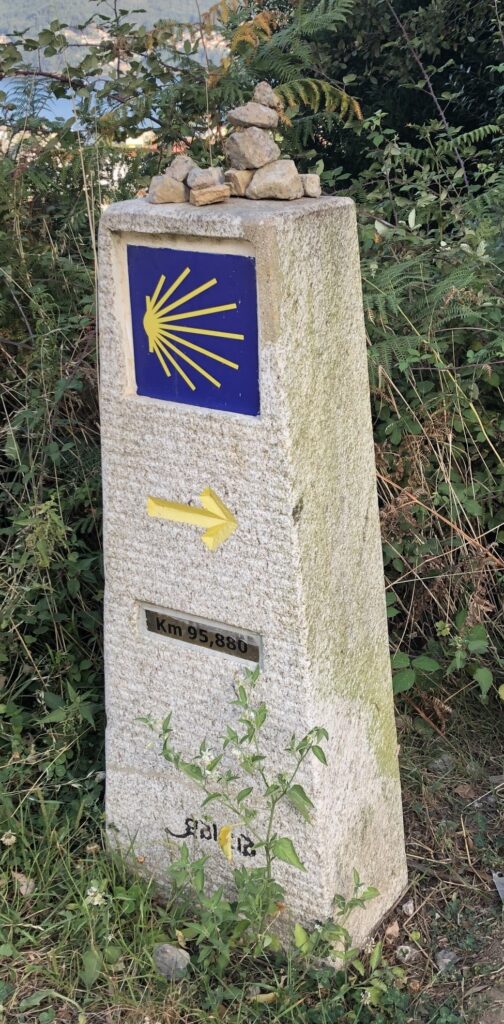
A collection of Camino shells, all pointing the way to Santiago de Compostela

ARRIVING IN SANTIAGO DE COMPOSTELA
On the last day we cycled into Santiago de Compostela. What an achievement – for us – and for everyone else arriving on the same day, by bike or by foot. That complete sense of accomplishment was felt by everyone, no matter where they started from, or when. We waited to receive our certificate and spoke to others and heard their stories. One person had started his walking pilgrimage in the UK. Some had done the full Camino. Each story, unique. These days, many do the Camino as a physical and mental challenge, or in honour of a special person. You see others on the route for whom the walk is a religious pilgrimage. The diversity along the route impressive and no matter how you do this trek you feel part of a global community.
Of course, we headed to the cathedral, an important stop for all pilgrims. At the time, it was undergoing extensive renovations. Notwithstanding all the scaffolding and cover-ups, you could see what a magnificent building it was. We also visited the town – Santiago de Compostela “old town” is a UNESCO-listed heritage site since 1985, with its university dating to 1495. So many people on the streets and in the cafes. There was a vibrancy I don’t think I had experienced before. We were staying a night in Santiago, and our accommodation was an old Monastery – such an appropriate place to stay for such a journey.
Our cycling journey had ended and we bid adios (Spanish) and adeus (Portuguese) to our fabulous guide. What a great week we had all had cycling together. From the early frustrations at the beginning of the week, to the exhilaration of completing more than 200 KMs of cycling several days later, we had shared so much. Now, we all had a whole new group of travel companions.
Where else can I ride my bike?
Where would you like to go?
Maybe we could go together?
3 highlights:
- Our amazing trilingual guide (English, Portuguese, Spanish) who made sure we all arrived at the daily destination safely and together
- The stories from fellow pilgrims, each unique
- The feeling of being awestruck as you contemplate the number of people who have done this pilgrimage over the centuries, and thinking about what they might have endured along the way
3 things for the next time:
- Visit the amazing Cathedral of Santiago de Compostela when the restorations are complete
- Choose a different route to cycle the Camino – there are so many! Maybe the traditional French Way? Or, the Camino del Norte which follows the coast of Northern Spain?

Recent Posts
Cycling Lake Constance
Art in Nature
Remember When Being Outside Was FUN?
All Categories

Camino Cycle
I was out cycling on the Camino Trail in 2019, which was my last major trip before Covid shut down the world. I had several planned for the following year – some still to be done.
I am not sure what led me to consider the Camino as a cycling route. I am so glad I did – it was an incredible experience, shared with an incredible group.
WHAT IS A CAMINO WAY CYCLE TOUR?
I knew some people who had hiked this pilgrimage journey to the Cathedral of Santiago de Compostela in Spain. However, hiking so far each day (~30K or 19M) for so many days in a row (e.g. 4-6 weeks for the classic Camino Francés route which is 680KM or 422M) did not really appeal to me. I likely went to a Camino site and read about cycling options. I learned that approximately 15% of pilgrims follow the route by bike, and that cyclists on the Camino are known as ‘bici-grinos’ (bike-pilgrims).
For those of you not familiar with the Camino, here is some background from https://caminoways.com/
The Camino de Santiago, also known as the Way of St. James, is a renowned pilgrimage of medieval origin that sees pilgrims journey to the Cathedral of Santiago de Compostela in Galicia in the northwest of Spain.
Legend has it that the remains of the Apostle St. James the Great were buried in the Cathedral and discovered by a shepherd in the 9th century. The city of Santiago is named after St. James: Santiago de Compostela means St. James of the Field of Stars.
Due to the enduring popularity of the Camino de Santiago and the many Camino routes, they have been listed as a UNESCO World Heritage Site since 1993. The Camino’s essential role has encouraged cultural exchanges between people from all over Europe and the world for many centuries.
The Camino de Santiago has been internationally recognised as one of the historic symbols of European unity. The pilgrim route was chosen as the first European Cultural Route by the Council of Europe in 1987. The Camino and the architecture along its routes are also listed as UNESCO World Heritage Sites.
The Camino pilgrimage has been around for over 1,000 years, dating back to the 9th century when the remains of Saint James were found in northern Spain. There are many routes to choose from, as traditionally the pilgrimage is supposed to start from your home.
After a lot of research, I decided to do the Portuguese Coastal route. The route was flatter than the mountainous route along the north of Spain, and at 252KM (157M) was comfortable over 6 days of cycling. And, I had never been to Portugal.
THE PORTUGUESE WAY
I was able to find a group of people willing to accompany me on this journey.
We had some drama on our first cycle morning as our tour provider had arranged for a bus to take us to the start. What we really needed was a smaller bus for 18 people and a cart for the bikes. What was there was a tour bus for 50 people. After a lot of discussion between our Portuguese speaking guide and driver, the decision was to put as many bikes as possible in the luggage compartment, and bring the rest inside the bus to sit in the aisle.
Not perfect, but it worked. Members of the group helped to store the bikes, we got to the destination, and the driver got a really good tip! Travelling sometimes involves unexpected things! My key lesson – always have a guide that speaks the local language! As we started cycling, I found out what “diverse terrain” meant. On Day 1 we had pavement, wooden paths, sand, rocks, construction, roots, hard packed earth. At one point we had to carry our bikes because the path was through a woodland area with dense trees. However, the good humour of the group prevailed and we successfully made our way into Esposende, a seaside city in northern Portugal.
Day 2 had a different challenge, called “hills”. Those who opted for an e-bike sailed up without effort. I had to walk the bike at times. Our strongest rider was 82 years old and conquered all the hills on the regular bike. You never know what skills and abilities group members have until you journey together.

Boat taxi for people and bikes
Wayfinding was quite easy along the route, the seashells kept you on track. It is said that the this symbol is a metaphor, with all the lines representing the routes travelled by pilgrams all leading to one point, the tomb of Saint James in Santiago de Compostela.
Examples of markers along the route to keep you on the right path to Santiago:



A collection of Camino shells, all pointing the way to Santiago de Compostela


ARRIVING IN SANTIAGO DE COMPOSTELA
On the last day we cycled into Santiago de Compostela. What an achievement – for us – and for everyone else arriving on the same day, by bike or by foot. That complete sense of accomplishment was felt by everyone, no matter where they started from, or when. We waited to receive our certificate and spoke to others and heard their stories. One person had started his walking pilgrimage in the UK. Some had done the full Camino. Each story, unique. These days, many do the Camino as a physical and mental challenge, or in honour of a special person. You see others on the route for whom the walk is a religious pilgrimage. The diversity along the route impressive and no matter how you do this trek you feel part of a global community.
Of course, we headed to the cathedral, an important stop for all pilgrims. At the time, it was undergoing extensive renovations. Notwithstanding all the scaffolding and cover-ups, you could see what a magnificent building it was. We also visited the town – Santiago de Compostela “old town” is a UNESCO-listed heritage site since 1985, with its university dating to 1495. So many people on the streets and in the cafes. There was a vibrancy I don’t think I had experienced before. We were staying a night in Santiago, and our accommodation was an old Monastery – such an appropriate place to stay for such a journey.
Our cycling journey had ended and we bid adios (Spanish) and adeus (Portuguese) to our fabulous guide. What a great week we had all had cycling together. From the early frustrations at the beginning of the week, to the exhilaration of completing more than 200 KMs of cycling several days later, we had shared so much. Now, we all had a whole new group of travel companions.
Where else can I ride my bike?
Where would you like to go?
Maybe we could go together?
3 highlights:
- Our amazing trilingual guide (English, Portuguese, Spanish) who made sure we all arrived at the daily destination safely and together
- The stories from fellow pilgrims, each unique
- The feeling of being awestruck as you contemplate the number of people who have done this pilgrimage over the centuries, and thinking about what they might have endured along the way
3 things for the next time:
- Visit the amazing Cathedral of Santiago de Compostela when the restorations are complete
- Choose a different route to cycle the Camino – there are so many! Maybe the traditional French Way? Or, the Camino del Norte which follows the coast of Northern Spain?

I was out cycling on the Camino Trail in 2019, which was my last major trip before Covid shut down the world. I had several planned for the following year – some still to be done.
I am not sure what led me to consider the Camino as a cycling route. I am so glad I did – it was an incredible experience, shared with an incredible group.
WHAT IS A CAMINO WAY CYCLE TOUR?
I knew some people who had hiked this pilgrimage journey to the Cathedral of Santiago de Compostela in Spain. However, hiking so far each day (~30K or 19M) for so many days in a row (e.g. 4-6 weeks for the classic Camino Francés route which is 680KM or 422M) did not really appeal to me. I likely went to a Camino site and read about cycling options. I learned that approximately 15% of pilgrims follow the route by bike, and that cyclists on the Camino are known as ‘bici-grinos’ (bike-pilgrims).
For those of you not familiar with the Camino, here is some background from https://caminoways.com/
The Camino de Santiago, also known as the Way of St. James, is a renowned pilgrimage of medieval origin that sees pilgrims journey to the Cathedral of Santiago de Compostela in Galicia in the northwest of Spain.
Legend has it that the remains of the Apostle St. James the Great were buried in the Cathedral and discovered by a shepherd in the 9th century. The city of Santiago is named after St. James: Santiago de Compostela means St. James of the Field of Stars.
Due to the enduring popularity of the Camino de Santiago and the many Camino routes, they have been listed as a UNESCO World Heritage Site since 1993. The Camino’s essential role has encouraged cultural exchanges between people from all over Europe and the world for many centuries.
The Camino de Santiago has been internationally recognised as one of the historic symbols of European unity. The pilgrim route was chosen as the first European Cultural Route by the Council of Europe in 1987. The Camino and the architecture along its routes are also listed as UNESCO World Heritage Sites.
The Camino pilgrimage has been around for over 1,000 years, dating back to the 9th century when the remains of Saint James were found in northern Spain. There are many routes to choose from, as traditionally the pilgrimage is supposed to start from your home.
After a lot of research, I decided to do the Portuguese Coastal route. The route was flatter than the mountainous route along the north of Spain, and at 252KM (157M) was comfortable over 6 days of cycling. And, I had never been to Portugal.
THE PORTUGUESE WAY
I was able to find a group of people willing to accompany me on this journey.
We had some drama on our first cycle morning as our tour provider had arranged for a bus to take us to the start. What we really needed was a smaller bus for 18 people and a cart for the bikes. What was there was a tour bus for 50 people. After a lot of discussion between our Portuguese speaking guide and driver, the decision was to put as many bikes as possible in the luggage compartment, and bring the rest inside the bus to sit in the aisle.
Not perfect, but it worked. Members of the group helped to store the bikes, we got to the destination, and the driver got a really good tip! Travelling sometimes involves unexpected things! My key lesson – always have a guide that speaks the local language! As we started cycling, I found out what “diverse terrain” meant. On Day 1 we had pavement, wooden paths, sand, rocks, construction, roots, hard packed earth. At one point we had to carry our bikes because the path was through a woodland area with dense trees. However, the good humour of the group prevailed and we successfully made our way into Esposende, a seaside city in northern Portugal.
Day 2 had a different challenge, called “hills”. Those who opted for an e-bike sailed up without effort. I had to walk the bike at times. Our strongest rider was 82 years old and conquered all the hills on the regular bike. You never know what skills and abilities group members have until you journey together.
Boat taxi for people and bikes

The next three days were wonderful and drama free. We cycled up the coast, often with the water by our side. We saw delightful towns such as Vigo, Pontevedra and Padron, each with its own character and unique features that made for special Instagram moments for everyone. So many charming statues, fountains, and churches. Taking the boat taxi from Portugal to Spain (one more time hauling bikes!) was really fun.
Wayfinding was quite easy along the route, the seashells kept you on track. It is said that the this symbol is a metaphor, with all the lines representing the routes travelled by pilgrams all leading to one point, the tomb of Saint James in Santiago de Compostela.
Examples of markers along the route to keep you on the right path to Santiago:




A collection of Camino shells, all pointing the way to Santiago de Compostela

ARRIVING IN SANTIAGO DE COMPOSTELA
On the last day we cycled into Santiago de Compostela. What an achievement – for us – and for everyone else arriving on the same day, by bike or by foot. That complete sense of accomplishment was felt by everyone, no matter where they started from, or when. We waited to receive our certificate and spoke to others and heard their stories. One person had started his walking pilgrimage in the UK. Some had done the full Camino. Each story, unique. These days, many do the Camino as a physical and mental challenge, or in honour of a special person. You see others on the route for whom the walk is a religious pilgrimage. The diversity along the route impressive and no matter how you do this trek you feel part of a global community.
Of course, we headed to the cathedral, an important stop for all pilgrims. At the time, it was undergoing extensive renovations. Notwithstanding all the scaffolding and cover-ups, you could see what a magnificent building it was. We also visited the town – Santiago de Compostela “old town” is a UNESCO-listed heritage site since 1985, with its university dating to 1495. So many people on the streets and in the cafes. There was a vibrancy I don’t think I had experienced before. We were staying a night in Santiago, and our accommodation was an old Monastery – such an appropriate place to stay for such a journey.
Our cycling journey had ended and we bid adios (Spanish) and adeus (Portuguese) to our fabulous guide. What a great week we had all had cycling together. From the early frustrations at the beginning of the week, to the exhilaration of completing more than 200 KMs of cycling several days later, we had shared so much. Now, we all had a whole new group of travel companions.
Where else can I ride my bike?
Where would you like to go?
Maybe we could go together?
3 highlights:
- Our amazing trilingual guide (English, Portuguese, Spanish) who made sure we all arrived at the daily destination safely and together
- The stories from fellow pilgrims, each unique
- The feeling of being awestruck as you contemplate the number of people who have done this pilgrimage over the centuries, and thinking about what they might have endured along the way
3 things for the next time:
- Visit the amazing Cathedral of Santiago de Compostela when the restorations are complete
- Choose a different route to cycle the Camino – there are so many! Maybe the traditional French Way? Or, the Camino del Norte which follows the coast of Northern Spain?

